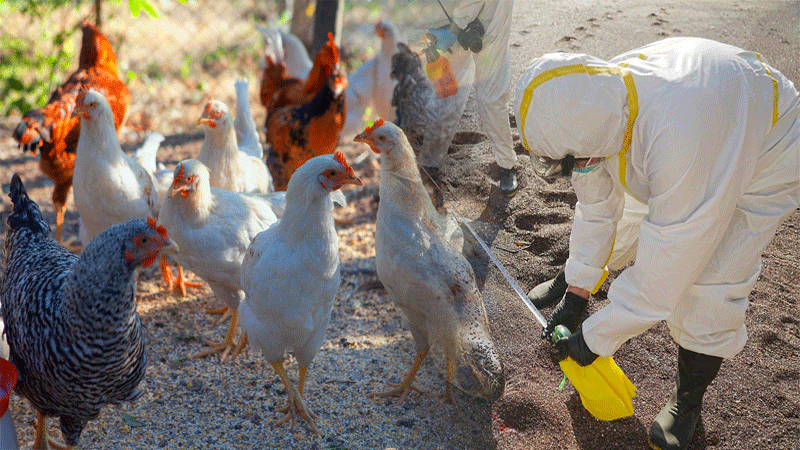Avian adenoviruses are classified into five distinct species, named Fowl Adenovirus A to E (FAdV-A to E), based on their biological and genetic characteristics.

Avian adenoviruses are a group of viruses that affect birds, causing a wide range of diseases that can impact the poultry industry significantly. These viruses belong to the Adenoviridae family, which also includes viruses that affect humans and other animals.
In recent years, there has been a growing interest in studying these viruses, and significant progress has been made in understanding their biology and pathogenesis.
Classification and Genomics:
Avian adenoviruses are classified into five distinct species, named Fowl Adenovirus A to E (FAdV-A to E), based on their biological and genetic characteristics.
Among these, FAdV-D is the most common species, and it has been associated with several clinical diseases in poultry, including hepatitis, gizzard erosion, and inclusion body hepatitis. Consistently, genotype-specific hexon L1 region (L1-hexon) could be utilized to identify all the FAdVs serotypes.
According to the sequence of L1-hexon, FAdV-1 is the only member in species FAdV-A, FAdV-5 is a unique member of species FAdV-B, FAdV-4 and FAdV-10 are members in species FAdV-C, FAdV-2, FAdV-3, FAdV-9 and FAdV-11 are members of species FAdV-D, and FAdV-6, FAdV-7, FAdV-8a, and FAdV-8b are members within species FAdV-E, respectively.
The genome of avian adenoviruses is a double-stranded DNA molecule, non-enveloped, icosahedral symmetry(70-90nm), linear genome ranging from 42 to 46 kilobases in length.
It encodes for various structural and non-structural proteins, including the Hexon (major capsid protein) and others are fiber and penton base proteins that are responsible for virus attachment and entry into host cells.
Pathogenesis and Clinical Diseases:
Pathogenesis:
Virus entry, primary replication, viremia and secondary replication then either death or immunity developed.
The pathogenesis of avian adenovirus infections is complex and involves various factors, including the age, immune status, and genetic background of the host, as well as the virulence and tropism of the virus.
Avian adenoviruses can infect various organs and tissues in birds, including the liver, spleen, lungs, kidneys, and gastrointestinal tract, leading to a wide range of clinical diseases.
In young birds, avian adenoviruses can cause respiratory diseases, characterized by coughing, sneezing, and nasal discharge. In older birds, these viruses can cause hepatic diseases, leading to liver necrosis, jaundice, and mortality.
Avian adenoviruses have also been associated with other clinical syndromes, such as inclusion body hepatitis, hydropericardium syndrome, and gizzard erosion.
Transmission:
No evidence of transmission from birds to humans has been identified The virus is mainly spread horizontally by the oro-fecal route, but vertical transmission can occur in serogroup 1.
Diagnosis and Control:
The diagnosis of avian adenovirus infections can be challenging due to the variable clinical signs and the co-infection with other pathogens. However, several laboratory tests can aid in the diagnosis, including virus isolation, PCR, serology, and histopathology.
- The control of avian adenovirus infections relies mainly on the implementation of strict biosecurity measures and vaccination programs. Vaccines based on inactivated or attenuated viruses have been developed and used widely in the poultry industry, providing effective protection against various clinical diseases caused by avian adenoviruses.
- Vaccines: Licensed vaccines in Pakistan includes: Avi-Hydro (Ottoman Pharma), Hydrofas (Intervac PVT. Ltd), Emulmax (ND+IBH) imported from Mexico.
- Outbreaks in spite of vaccination.
Research and Future Perspectives:
Research on avian adenoviruses has been ongoing for several decades, with a particular focus on understanding their biology, pathogenesis, and epidemiology.
Recent advances in genomic and proteomic technologies have provided new insights into the molecular mechanisms underlying avian adenovirus infections, leading to the development of new diagnostic tools and vaccine candidates.
In the future, it is expected that the continued research on avian adenoviruses will lead to the development of more effective vaccines, diagnostic tests, and antiviral drugs.
Moreover, the knowledge gained from studying these viruses can also have implications for understanding the biology of other adenoviruses that affect humans and animals.
Conclusion:
In conclusion, avian adenoviruses are a group of viruses that pose a significant threat to the poultry industry worldwide. These viruses cause a wide range of clinical diseases in birds, leading to substantial economic losses.
However, significant progress has been made in understanding the biology and pathogenesis of avian adenoviruses, leading to the development of effective control measures. Continued research on these viruses is necessary to ensure their effective control and to gain insights into the biology of other adenoviruses.